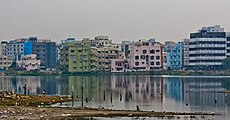
Once upon a time, Hyderabad was known as City of Lakes. Some of these lakes are natural and various are manmade bodies. As per various sources only a few decades back, Hyderabad had a large number of water bodies such as lakes, reservoirs, rivers, streams, aquaculture ponds, tanks etc. (as per some sources between 3000 and 7000 including natural and manmade bodies. Locally known as cheruvu, kunta, tanks ). As per the data from National Remote Sensing Centre, between 1979 and 2023 there has been a reduction of 61% in city’s lake area. Area occupied by 56 lakes were examined and it was found that the total area of these lakes has shrunk from 40.35 km (15.58 sq mi) 16 km (6.2 sq mi). Most of these lakes have totally disappeared and the surface area of most of the surviving lakes have shrunken and turned to tiny ponds and cesspool. Some of the lakes which have totally disappeared are Tigal Kunta, Somajiguda Tank, Mir Jumla tank, Pahar Tigal Kunta, Kunta Bhawani Das, Nawab Saheb Kunta, Afzalsagar, Nallakunta, Masab Tank etc. Hussainsagar Lake, Kunta Mallaiyapalli have shrunk drastically. Out of thousands of water bodies those were existing in 1970s in various sizes in and around Hyderabad, today only about 70 to 500 of them have survived. Most of them have disappeared due to encroachment or have been illegally drained for real estate projects by private or government agencies. The existing lakes have been used to dump garbage and sewage water. Most of these lakes and tanks were built during the regime of Qutub Shah in 16th and 17th century and later by Nizams as a source of drinking water for the residents of Hyderabad. The area of Hussain Sagar, which is the largest lake in Hyderabad shrunk by more than 40% i.e. from 550 ha to 349 ha in just 30 years. This lake was built in 1575 AD and since 1930 is not being used as a source for drinking water.



Similarly, the area occupied by Shamirpet lake shrunk from 486 ha in 1989 to 256 ha in 2006. In total about 3245 ha of water bodies were lost in 12 years (from 1989 to 2001).
As of 2010, 500 lakes were under HUDA jurisdiction. As of May 2018, HUDA maintains record of 169 lakes which occupy an area of more than 10 hectares. Out of this 62 lakes were under the control of government, 25 are owned by private organisations and 82 lakes are under joint government private ownership. As per existing government norms, no construction of any kind, irrespective of the ownership status is allowed on the lake bed. This rules are frequently violated both by government and private agencies. The Jubilee Bus Station is located where once the Picket lake used to exist. Madhapur the IT hub of Hyderabad once used to be a network of lakes. The MaSaheba Tank which is now Masab Tank has also almost disappeared and today is occupied by various residential and commercial buildings.
Some surviving lakes are listed below. Some of them are under restoration with funds provided by the National Lake Conservation Plan. Out of the 169 large water bodies notified by HUDA, in first phase it was proposed to restore 87 lakes.
- Alwal Lake
- Ameenpur Lake
- Aryana Cheruvu
- Bon Cheruvu
- Bum Rukn-Ud-Daula lake
- Durgam Cheruvu
- Fox Sagar Lake or Jeedimetla Cheruvu
- Himayat Sagar
- Hussain Sagar
- Jeedimetla Cheruvu or Fox Sagar Lake
- Kamuni Cheruvu
- Kapra Lake
- Khajaguda Lake or Nanakramguda lake (Wipro lake)
- Khajaguda Talab (Pedda Cheruvu)
- Langarhouz Cheruvu
- Malkam Cheruvu
- Manikonda Cheruvu (Yellama Cheruvu), near Lanco Hills
- Mir Alam Tank
- Mushkin Cheruvu
- Mundikunta Lake
- Jalpally lake
- Nacharam Cheruvu
- Nallagandla Lake
- Neknampur Lake
- Osman Sagar
- Ramakrishnapuram Lake
- Ramanthapur Cheruvu
- Rangadhamuni Cheruvu (IDL Lake), Kukatpally
- Safilguda Lake
- Saroornagar Lake
- Shamirpet Lake
See also
- Stepwells in Hyderabad
- Lakes in Bangalore
References
- "Explained: Why the 2,800 lakes in Hyderabad could not prevent a flood this year". 21 October 2020.
- ^ Rajani, Amisha (13 August 2024). "61% of Hyderabad's lake area shrunk in 44 years". Times of India. Retrieved 14 October 2024.
- B., Nitin (28 December 2018). "Say your goodbyes to Hyderabad lakes". The NEWS Minute. Hyderabad. Retrieved 5 November 2018.
- Gumma, Ravi Kumar (September 2013). GROUND WATER BROCHURE (PDF). CENTRAL GROUND WATER BOARD, MINISTRY OF WATER RESOURCES, GOVERNMENT OF INDIA (Report). Hyderabad: MINISTRY OF WATER RESOURCES, GOVERNMENT OF INDIA. Retrieved 8 November 2018.
- Nanisetti, Serish (14 October 2017). "In Hyderabad, lakes are nothing but urban myths". The Hindu. Hyderabad. Retrieved 5 November 2018.
- "WHY IS HYDERABAD RUNNING OUT OF WATER?". World Wildlife Fund. Retrieved 8 November 2018.
- "Hyderabad's water blues: Lakes, rivers fall prey to urbanisation" (PDF). RainWaterHarvesting.org. Retrieved 8 November 2018.
- "CASES ON PROTECTION OF LAKES". Centre for Science and Environment. 9 May 2011. Retrieved 8 November 2018.
- Prakash, Anjal (4 March 2013). Written at Hyderabad. Lakes of Hyderabad: Would they survive? (PDF). South Asia Consortium for Interdisciplinary Water Resources Studies (Report). New Delhi: Centre for Science and Environment. Retrieved 9 November 2018.
- "Hyderabad: Over 3,000 water bodies disappear in 2 decades". Deccan Chronicle. Hyderabad. 5 May 2018. Retrieved 8 November 2018.
- http://www.worldlakes.org/uploads/Management_of_lakes_in_India_10Mar04.pdf Management of Lakes in Inda
- "Hyderabad: Most lakes are either dead or dying". Times of India. Hyderabad. 5 June 2017. Retrieved 5 November 2018.
- Bharat Lal Seth (4 July 2015). "Lakes do the disappearing act". DownToEarth. Retrieved 5 November 2018.
- Ranjan, Jayesh. Conservation of Urban lakes in Hyderabad Urban Area (PDF). HUDA (Report). Hyderabad: HUDA. Retrieved 9 November 2018.